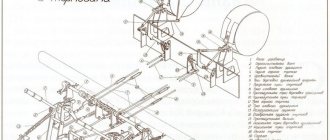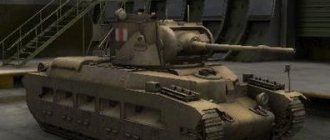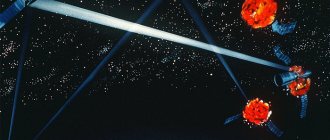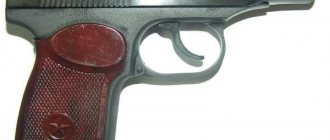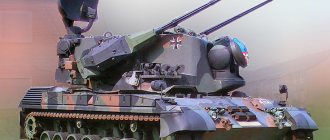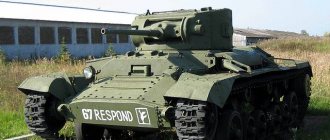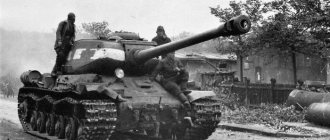Relaunch of the collection, autumn 2022. The collection is available only by subscription. The new magazine collection Tank T-34 will allow you to independently assemble an accurate scale model of the famous T-34 tank on a scale of 1:16. Each issue of the magazine comes with quality parts to assemble your model. Eaglemoss Publishing.
During World War II, the T-34 was the most mass-produced tank and became a legendary fighting vehicle of the Red Army. It combined high firepower, maneuverability and speed, and played a significant role in pushing the Wehrmacht troops back towards Germany.
Model
To assemble a unique model you do not need special skills. All parts are attached using grooves and screws. With each release of the collection, you will receive another set of parts and step by step you will be able to assemble your own model. The metal elements of the future model convey the true power of a real tank, and inside the model looks exactly like its prototype - from the crew compartment to the engine compartment. The tank has internal lighting.
- The model that you have to assemble is made on a large scale - 1:16 and reproduces with maximum accuracy the legendary T-34-85 of 1945 with a ZIS 85 mm caliber cannon.
- Moving tracks and wheels, rotating turret with cannon, detailed interior, opening hatches.
- Each part is made of high-quality material: from metal to high-strength ABS plastic.
- The model corresponds to a tank that took part in the battles in the spring of 1945 against Nazi Germany, as part of the 26th Guards Tank Brigade.
- All parts of the model are already painted.
- To assemble a tank model, all you need is a diagram from a magazine and a screwdriver.
T-34 1941
Performance characteristics
| T-34 mod. 1941 | |
| Length, m | 5,92 |
| Length with gun, m | 6,62 |
| Width, m | 3,0 |
| Height, m | |
| Combat weight, t | |
| Armament | |
| A gun | 1 x 76 mm F-34 |
| Machine guns | 2 x 7.62 mm DT |
| Mobility | |
| Max speed on highway, km/h | 54 |
| Cruising range on the highway, km | 300 |
| Booking | |
| Body forehead, mm | 45 |
| Sides and stern of the hull, mm | 40-45 |
| Tower forehead, mm | 40-45 |
| Sides and stern of the tower, mm | 45 (52) |
| Roof, mm | 15-20 |
| Bottom, mm |
Magazine
Each issue of the T-34 Tank magazine describes in detail the next stage of model assembly. And fascinating stories about the creation of Soviet tanks and the development of the T-34 model will inspire you to create a smaller copy of it.
The magazine contains many exciting essays about great battles involving the T-34 and about the people who were directly related to the creation of the legendary tank.
T-34
Performance characteristics
| T-34 mod. 1940 | |
| Length, m | 5,92 |
| Length with gun, m | 5,96 |
| Width, m | 3,0 |
| Height, m | 2,41 |
| Combat weight, t | 25,6 |
| Armament | |
| A gun | 1 x 76mm L-11 |
| Machine guns | 2 x 7.62 mm DT |
| Mobility | |
| Max speed on highway, km/h | 54 |
| Cruising range on the highway, km | 300 |
| Booking | |
| Body forehead, mm | 45 |
| Sides and stern of the hull, mm | 40-45 |
| Tower forehead, mm | 40-45 |
| Sides and stern of the tower, mm | 45 |
| Roof, mm | 15-20 |
| Bottom, mm | 13-16 |
T-34 1943
Performance characteristics
| T-34 mod. 1943 | |
| Length, m | 5,92 |
| Length with gun, m | 6,62 |
| Width, m | 3,0 |
| Height, m | 2,52 |
| Combat weight, t | 30,9 |
| Armament | |
| A gun | 1 x 76 mm F-34 |
| Machine guns | 2 x 7.62 mm DT |
| Mobility | |
| Max speed on highway, km/h | 54 |
| Cruising range on the highway, km | 300 |
| Booking | |
| Body forehead, mm | 45 |
| Sides and stern of the hull, mm | 40-45 |
| Tower forehead, mm | 40-45 |
| Sides and stern of the tower, mm | 45 (52) |
| Roof, mm | 15-20 |
| Bottom, mm | 13-20 |
Firepower
Firepower
Early T-34 tanks were equipped with a 76-mm cannon mod. 1938/39 L-11 with a barrel length of 30.5 calibers and an initial armor-piercing projectile speed of 612 m/s. Vertical aiming - from -5° to +25°. The practical rate of fire in a tank is 1–2 rounds/min. The gun had a vertical wedge semi-automatic breech with a device for disabling semi-automatic guns, since in the pre-war years the leadership of the GABTU believed that there should be no semi-automatic guns in tank guns (due to gas contamination in the fighting compartment). A special feature of the L-11 gun was its original recoil devices, in which the fluid in the recoil brake was in direct contact with atmospheric air through a small hole.
Stuck in a water meadow and abandoned by the crew of a pre-war T-34, armed with an L-11 cannon. Western Front, July 1941. Floodplain of the river Driving near Tolochin.
German soldiers inspect a damaged T-34 tank. Summer 1941. This vehicle is equipped with a cast turret, which was rare - most of the pre-war T-34s, especially the earlier ones with the L-11 cannon, had welded turrets.
The main drawback of this weapon was also associated with this circumstance: if it was necessary to alternately fire quickly at different angles of elevation of the barrel (which was not uncommon in a tank), the hole was blocked, and the liquid boiled when fired, bursting the brake cylinder. In order to eliminate this drawback, a reserve hole with a valve was made in the L-11 recoil brake for communication with air when firing at a declination angle. The L-11 gun, in addition, was very complex and expensive to produce. It required a wide range of alloy steels and non-ferrous metals; the manufacture of most parts required milling work of high precision and cleanliness.
Since the L-11 gun did not become a massive tank gun of the Great Patriotic War, and the T-34 tanks on which it was installed were mostly lost in its first month, there is no point in dwelling in detail on its combat characteristics. So let’s immediately move on to the most popular (about 37 thousand guns were produced) domestic tank gun F-34.
L-11 gun.
Tank T-34 with 76 mm
ear of the F-34 during testing at the Gorokhovets training ground. November 1940.
76 mm gun mod. 1940 F-34 with a barrel length of 41.5 calibers was installed on the T-34 from March 1941. Gun weight 1155 kg. Maximum rollback length 390 mm, vertical aiming from -5°30? to +26°48?. The shutter is wedge, with semi-automatic mechanical copy type. The gun's recoil devices consisted of a hydraulic recoil brake and a knurler and were located under the barrel. The cannon was fired using foot and manual mechanical triggers.
The F-34 gun has been modernized twice.
Armor penetration of 76 mm shells.
The swinging part of the F-34 cannon with a telescopic sight.
Standard mask installation of the F-34 gun.
Simplified mask installation of the F-34 cannon designed by plant No. 264 (Stalingrad shipyard).
During the first improvement, the bolt and semi-automatic mechanism with a copying device, trigger mechanisms were changed, the compensator in the recoil brake, the safety lock for locking the bolt in a traveling manner, and the bracket with the buffer were eliminated.
In the second case, instead of a barrel with a free pipe, they installed a monoblock barrel with a breech, connected to the pipe using a coupling.
For firing from the L-11 and F-34 guns, unitary cartridges from divisional guns mod. 1902/30 and arr. 1939 and from the regimental gun mod. 1927 In October 1943, a unitary cartridge with a sub-caliber armor-piercing tracer projectile (BR-354P) was adopted and began to be included in the ammunition load of the T-34 tank.
Assembly of towers in the workshop of the Chelyabinsk Kirov Plant. 1943 The front turret has not yet been equipped with movable armor for the F-34 cannon.
T-34 with troops on armor before the attack. Southwestern Front, 5th Guards Tank Brigade, May 1942.
From the data given in the table it is clear that the 76-mm F-34 cannon installed in the T-34 tank at a range of up to 1500 m was guaranteed to hit the armor of all German tanks without exception in 1941–1942, including Pz.III and Pz.IV. As for the new German heavy tanks, it could penetrate the frontal armor of the Tiger and Panther tanks from a distance of no more than 200 m, and the side armor of the Tiger, Panther and Ferdinand self-propelled guns - from a distance of no more than 400 m.
However, in practice things were somewhat different. For example, a memorandum on the results of shelling tests of the Pz.VI tank, sent to Stalin on May 4, 1943, stated: “The shelling of the 82-mm side armor of the T-VI tank from a 76-mm F-34 tank gun from a distance of 200 meters showed that that the armor-piercing shells of this gun are weak and when they meet the armor of a tank they are destroyed without penetrating the armor.
76-mm sub-caliber shells also do not penetrate the 100-mm frontal armor of the T-VI tank from a distance of 500 m.”
Medium tank T-34. Southwestern Front, summer 1942.
Tank T-34 production in a combat position. 2nd Baltic Front, 1945.
As for the Panther tanks, based on the results of the battles on the Kursk Bulge, it was concluded that they are hit by a 76-mm armor-piercing projectile, with the exception of the frontal part. After the end of the fighting, one Panther was subjected to test fire from the 76-mm cannon of the T-34 tank. A total of 30 shots were fired with armor-piercing shells from a distance of 100 m, of which 20 shots were fired at the upper and 10 shots at the lower frontal plate of the hull. The top sheet had no holes - all the shells ricocheted; the bottom sheet had only one hole.
Thus, it can be stated that in 1943, with the increase in the thickness of the armor of German tanks, the effective firing range at them sharply decreased and did not exceed 500 m even for a sub-caliber projectile. At the same time, 75 mm and 88 mm long-barreled German guns could hit the T-34 at distances of 900 and 1500 m, respectively.
Crew members of a T-34 tank place 76mm rounds into "suitcases" before loading them into the tank. Southern Front, 1942.
T-34 with an “improved” turret at the Polish Army Museum in Warsaw.
Indeed, by the summer of 1943 and even earlier, our tanks had lost their advantage over the German ones. The design of the T-34 tank was improved rather sluggishly. And while some innovations can still be recalled with regard to armor protection and the engine transmission unit, the same cannot be said with regard to weapons. Since March 1940, it has remained unchanged - the F-34 cannon. It is completely unclear why V.G. Grabin did not even try to improve the ballistic characteristics of this gun. Why was it impossible, for example, to bring them to the level of the F-22 cannon by lengthening the F-34 barrel to 55 calibers? With the previous shell, such a weapon could penetrate 82 mm armor from a distance of 1000 m!
This would equalize the chances of success in a duel between the T-34 and the Pz.IV, for example, and would significantly increase them when meeting with the Tiger or Panther.
Early T-34-85 tanks were equipped with an 85-mm D-5T (or D-5-T85) cannon with a barrel length of 51.6 calibers. Gun weight 1530 kg. The maximum rollback length is 320 mm.
The gun had a wedge breech, similar in design to the breech of the F-34 cannon, and a semi-automatic copy type. The recoil devices consisted of a hydraulic recoil brake and a hydropneumatic knurl and were located above the barrel: on the right side there was a knurl, on the left there was a recoil brake.
Since March 1944, the T-34-85 tank was equipped with an 85-mm S-53 (and then ZIS-S-53) gun mod. 1944 with a barrel length of 54.6 calibers. The mass of the swinging part of the gun without armor is 1150 kg.
The maximum rollback length is 330 mm. Vertical aiming from -5° to +22°. The gun bolt is a vertical wedge with a semi-automatic copy type. The gun's trigger mechanism consisted of electric and mechanical (manual) triggers. The electric release lever was located on the handle of the lifting mechanism flywheel, and the manual release lever was located on the left shield of the gun fence.
For firing from 85-mm tank guns, standard ammunition from an 85-mm anti-aircraft gun mod. 1939 (see table).
The turret of this tank was torn off by an internal explosion. Unfortunately, the 76-mm ammunition detonated quite often. Spring 1942.
If we take the German heavy tank "Tiger" as a kind of calculation unit, then we can state that its frontal armor was pierced by 85-mm cannons at a range of 1000 m. When firing at the tank "Tiger" from a range of 1500 m, there remained in its frontal hull plate only a dent 39 mm deep, and at a distance of 800 m a gap measuring 350 by 230 mm formed in the side of the turret box. The 85-mm cannon of the Ferdinand self-propelled gun and the Royal Tiger heavy tank penetrated only the side and rear armor plates of the hull and turret.
T-34-85 tanks with D-5T guns. 38th separate tank regiment. The tank column “Dimitri Donskoy” was built with funds from the Russian Orthodox Church. Winter 1944.
T-34-85. An intermediate model that retained some of the characteristic details of the early Sormovo machines - the external fuel tank shifted forward and eyelets made of rod.
It should be noted that in terms of manufacturing quality, Soviet armor-piercing shells were somewhat inferior to German ones, which did not allow the full potential of tank guns to be used. At the same time, the comparison with German heavy tanks looks incorrect, since the T-34-85, being a massive tank of the Red Army, more often dealt with the Pz.IV and the Panther. The first was hit by an 85-mm armor-piercing projectile at almost all firing distances, while the situation with the second was much worse. The frontal plate of the Panther's hull was 85 mm thick and tilted to the horizon at 35°; the T-34-85 tank's gun could only penetrate it from a distance not exceeding 500 m.
The breech of the 85-mm ZIS-S-53 cannon.
The eyepiece and forehead of the TSh-16 sight are clearly visible, on the left is the turret rotation mechanism, and below is the gun’s vertical aiming flywheel.
As is known, the fire maneuverability of any tank is determined by the angular speed of rotation of the turret. The turret of the T-34 tank rotated around its vertical axis using a rotation mechanism located on the left side of the gun. The turret rotation mechanism was a reduction worm gear. To quickly transfer fire from one target to another, an electromechanical drive was used, and a manual drive was used to accurately aim the gun at the target. The electric drive of the turret rotation mechanism had three rotation speeds. The electric motor was controlled by turning the rheostat handwheel (controller) mounted on it. To turn the tower to the right, the handwheel was turned to the right, to turn it to the left, to the left. When turning, the rheostat handwheel had three positions in each direction, corresponding to three turret rotation speeds, which had the following values: 1st speed - 2.1 rpm, 2nd - 3.61 rpm, 3rd - 4.2 rpm Thus, the time for a full rotation of the tower at maximum speed was a record 12 seconds! In the neutral position (manual drive), the handwheel was locked using a button. Everything seems to be fine. But the fact is that the turret rotation mechanism of the T-34 tank had an extremely unsuccessful design with separated control drives.
Let's imagine a tank gunner in battle. His face is pressed to the forehead of the sight, that is, he does not look around and manipulates the gun’s aiming organs blindly. The right hand rests on the vertical guidance flywheel, the left hand rests on the flywheel for the manual turret rotation drive. According to the recollections of some tankers, they crossed their arms, rotating the right flywheel of the turret rotation mechanism. Perhaps it was more convenient this way. To switch to the electric drive, the gunner had to stretch out his hand (it was difficult to do this with his left hand, but with his right hand) and use it to feel for the small controller handwheel located on the top of the rotation mechanism. At the same time, it was necessary to remember to switch from a manual drive to an electromechanical one by pressing a small button next to the handwheel. As they say, “everything is clear to the court” - no normal person in the heat of battle would do all this. Therefore, the gunners of the “thirty-fours” mainly used only the manual drive for turning the turret. To a large extent, their choice was made easier by the fact that on tanks produced in the winter of 1941–1942, for example, there was no electric drive for turning the turret at all - electric motors were not supplied to the factories.
T-34-85 mod. 1944
Compared to the T-34, the T-34-85 has significantly improved fire maneuvers. The turret rotation mechanism had a combined control of manual and electric drives, which greatly facilitated its use. Using an electric drive, the tower made a full rotation in 12–15 seconds.
To fire from the L-11 cannon, the TOD-6 telescopic sight and the PT-6 periscopic panoramic sight were used; for firing from the F-34 cannon - the TO D-7 telescopic sight and the PT-7 periscopic panoramic sight, later replaced by the TMFD-7 telescopic sight and the PT-4-7 periscopic panoramic sight. In addition to the standard periscope sight, some tanks were equipped with a PT-K commander's panorama.
The TMFD-7 telescopic sight had a 2.5x magnification and a field of view of 15°. It provided greater pointing accuracy, but working with it was inconvenient, since the eyepiece part moved with the gun, which means the gunner had to either slide from his seat, giving the gun barrel an elevation angle, or stand up from it, giving the declination angle. The periscope sight, unlike the telescopic sight, was mounted not on the gun, but in the roof of the turret. It provided all-round visibility with a fixed eyepiece. The head prism of the sight was connected to the gun by a parallelogram drive. The PT-4 sight had lower pointing accuracy due to errors introduced by the parallelogram traction device and the differential mechanism.
Movable armor for the DT machine gun.
Since September 1943, T-34 tanks began to be equipped with PT-9 periscope sights without an all-round viewing mechanism.
For direct fire from the D-5T cannon, the TSh-15 telescopic sight and the PTK-5 periscopic sight were used, and from the S-53 and ZIS-S-53 cannons, the TSh-16 telescopic sight was used. For shooting from closed positions - a side level and a turret inclinometer.
Telescopic sights TSh-15 and TSh-16 had a 4x magnification and a field of view of 16°. Both of them had an optical hinge consisting of four mirrors. The head part of the sight was rigidly mounted on the swinging part of the gun, and the eyepiece part was stationary, which significantly improved the gunner’s working conditions.
In tanks produced in 1940–1942, the ammunition load consisted of 77 rounds, which were placed on the floor of the fighting compartment and on its walls. 20 high (for 3 shots) and 4 low (for 2 shots) suitcases were installed on the floor of the tank - a total of 68 shells. There were 9 shots placed on the walls of the fighting compartment: on the right side - 3, in a common horizontal stacking, and on the left - 6, in two horizontal stacks, 3 shots each.
In tanks produced in 1942–1944 with an “improved” turret, the ammunition load consisted of 100 rounds (armor-piercing - 21, high-explosive fragmentation - 75, sub-caliber - 4). To store shots on the floor of the fighting compartment, 8 boxes for 86 shots were equipped. The remaining 14 rounds were placed as follows: 2 armor-piercing tracers - in cassettes on the lid of the box in the right rear corner of the fighting compartment, 8 high-explosive fragmentation rounds - on the left side of the fighting compartment, and 4 sub-caliber ones - in cassettes on the right side.
Thus, in the “first shot fenders” of the T-34 tank of early releases with the “pie” turret there were 9 shots, and with the “improved” turret - 14. For the rest, the loader had to climb into suitcases or boxes. It was more difficult with the first ones, since their design provided access to only one upper shot. In the boxes, the shots were placed horizontally, and with the lid open, access to several shots was provided at once.
The 85-mm gun's ammunition consisted of 55 artillery rounds (fragmentation rounds - 36, armor-piercing rounds - 14, sub-caliber rounds - 5) and was placed in the hull and turret of the tank in three types of stowage: rack, clamp and box.
“And we finished our campaign on the Pacific Ocean.” Dalian area, August 1945. The picture shows T-34-85 tanks with a low late-type commander's turret.
The rack for 12 shots was located in the niche of the tower. It included fragmentation grenade shots.
The clamp racks were located: on the right side of the turret - for 4 artillery rounds; in the control compartment on the starboard side of the hull - for 2 artillery rounds; in the right rear corner of the fighting compartment - for 2 artillery rounds. On the right side of the turret shots with armor-piercing shells were stacked, and in the control and combat compartments - with sub-caliber shells. Thus, the T-34-85 had 20 artillery rounds in constant readiness to immediately open fire.
Six boxes located on the bottom of the fighting compartment contained 35 rounds, of which: 24 with a fragmentation grenade, 10 with an armor-piercing projectile and 1 with a sub-caliber one.
T-34 1942
Performance characteristics
| T-34 mod. 1942 | |
| Length, m | 5,92 |
| Length with gun, m | 6,62 |
| Width, m | 3,0 |
| Height, m | |
| Combat weight, t | |
| Armament | |
| A gun | 1 x 76 mm F-34 |
| Machine guns | 2 x 7.62 mm DT |
| Mobility | |
| Max speed on highway, km/h | 54 |
| Cruising range on the highway, km | 300 |
| Booking | |
| Body forehead, mm | 45 |
| Sides and stern of the hull, mm | 40-45 |
| Tower forehead, mm | 40-45 |
| Sides and stern of the tower, mm | 45 (52) |
| Roof, mm | 15-20 |
| Bottom, mm |
Reviews
Reviews about the Tank T-34 collection. Tank T-34 No. 1 - demo card of the first issue.
In my opinion, the model has serious inaccuracies that will have to be dealt with. The absence of welds, the texture of a cast turret (you need to imitate it yourself), cracks (you have to putty), track tracks assembled with screws (not on fingers), etc., etc. This spoils the impression of the model. In any case, this is exactly what the model looks like in the photo in the magazine. Konstantin
.
The tank is good, but... The turret is model 1944. Additional headlight, rollers, spare parts on the left side were produced after 1945 (the tank was produced until 1946). Vyacheslav
.
